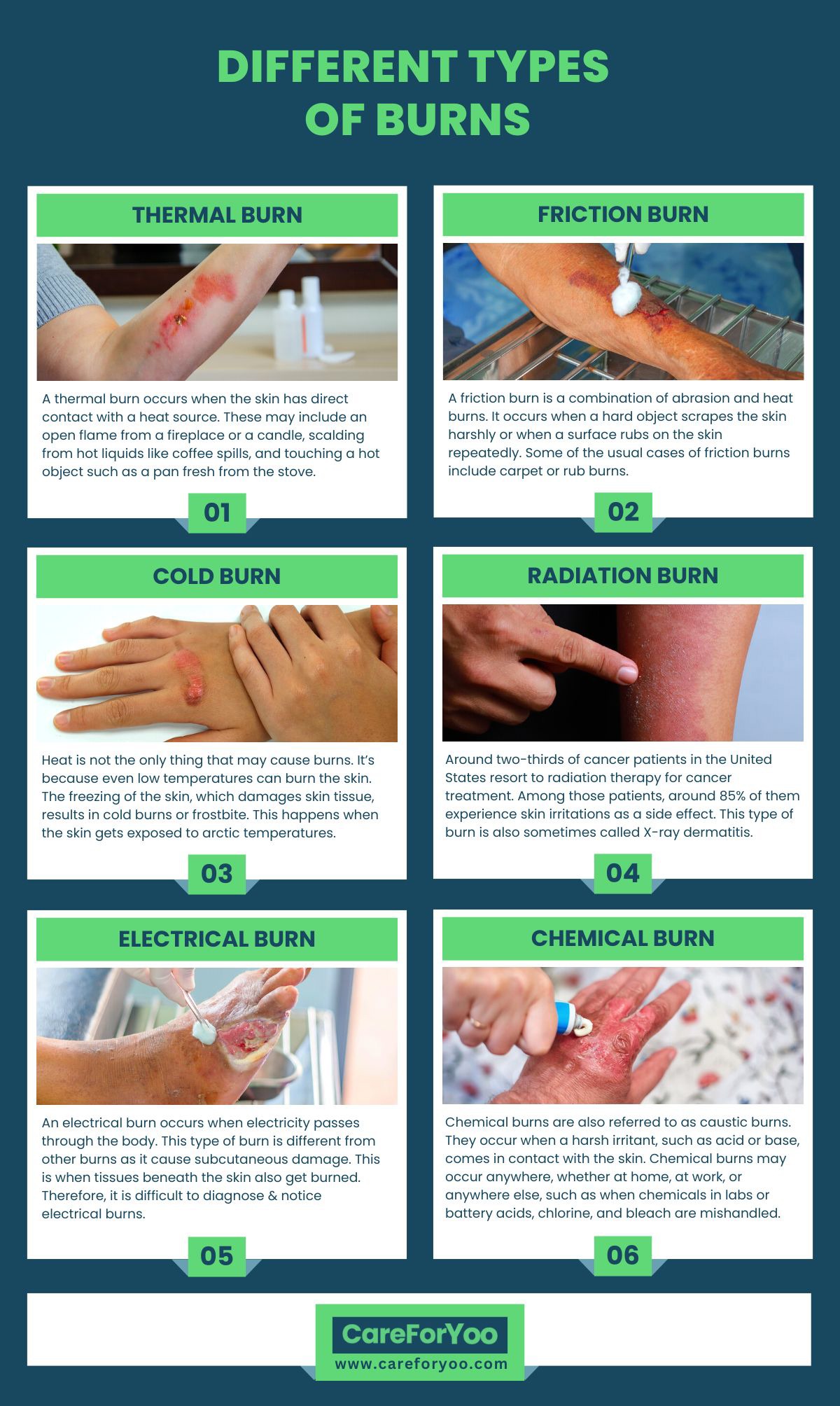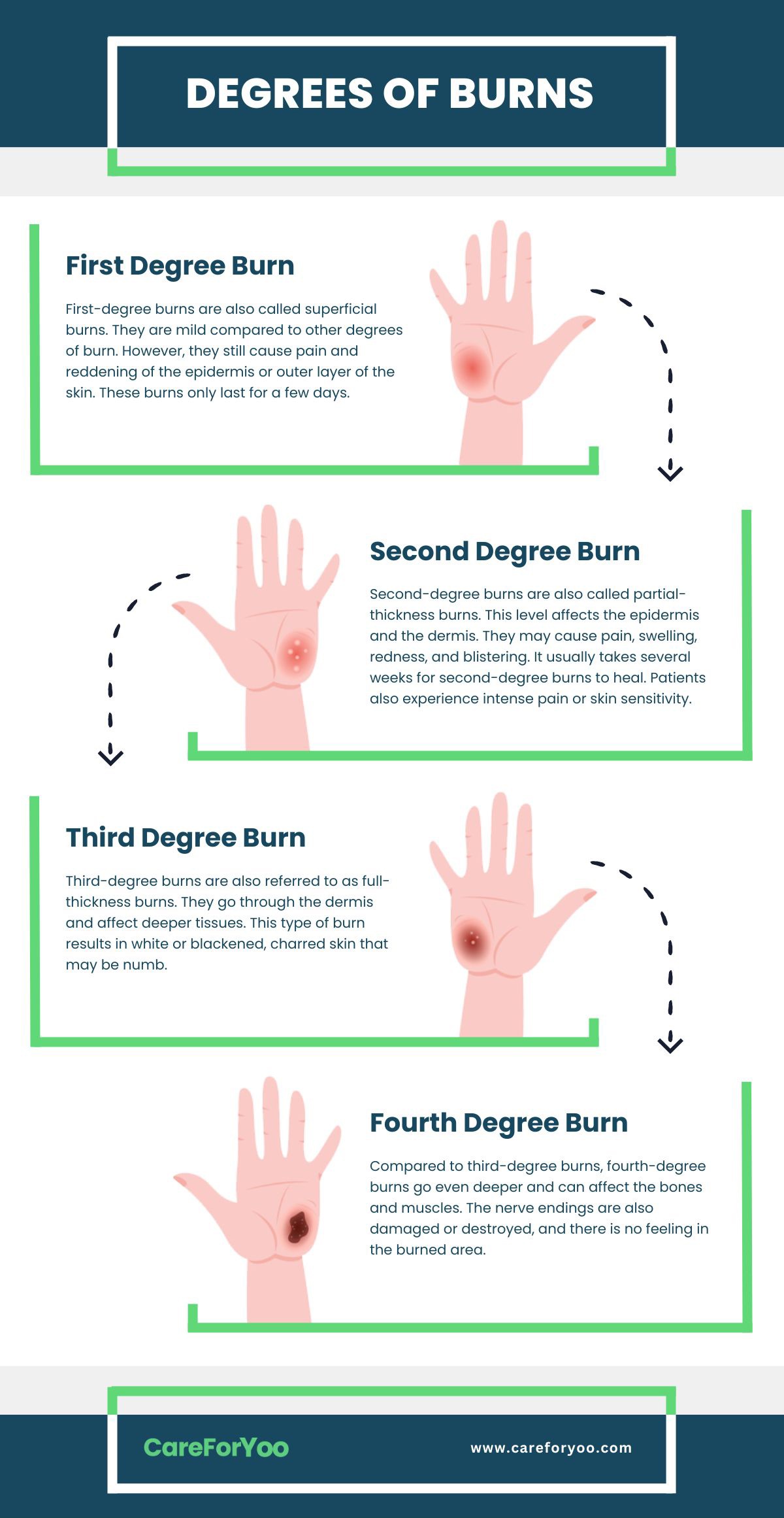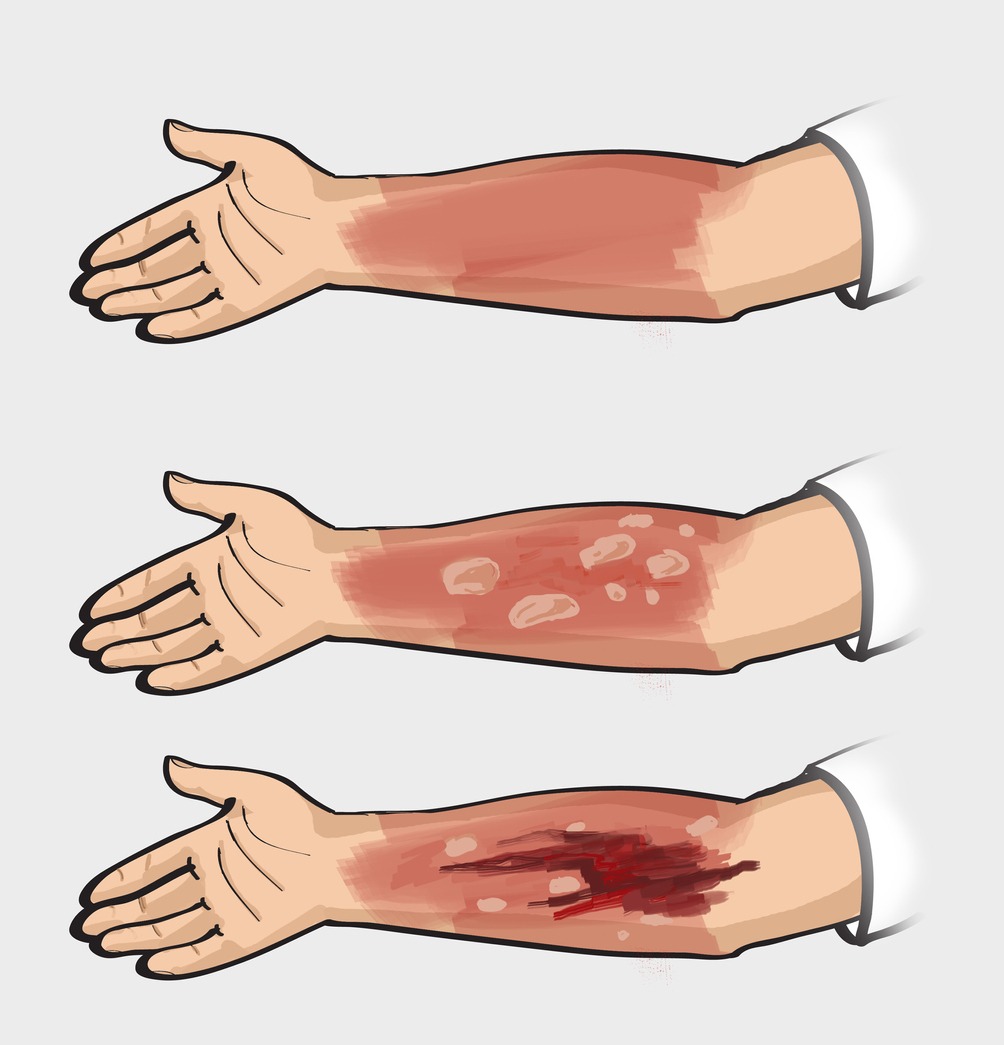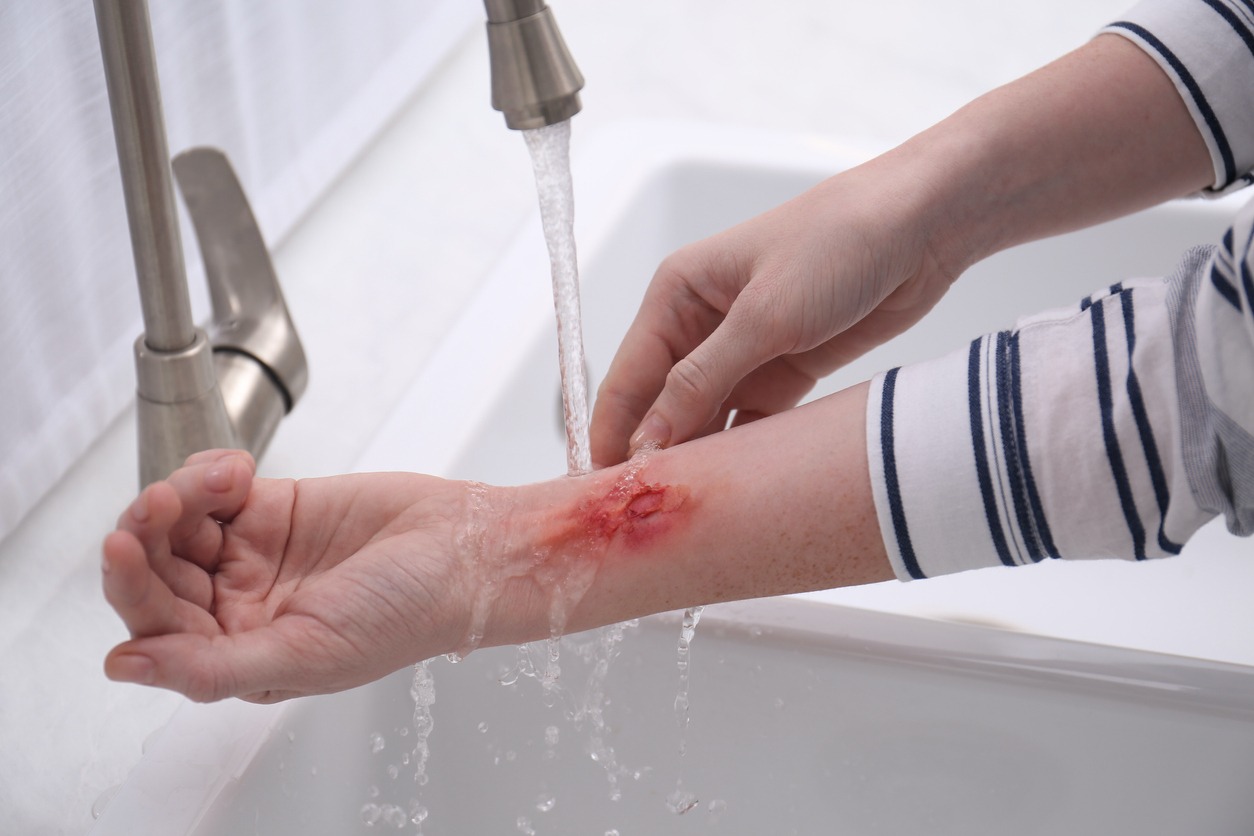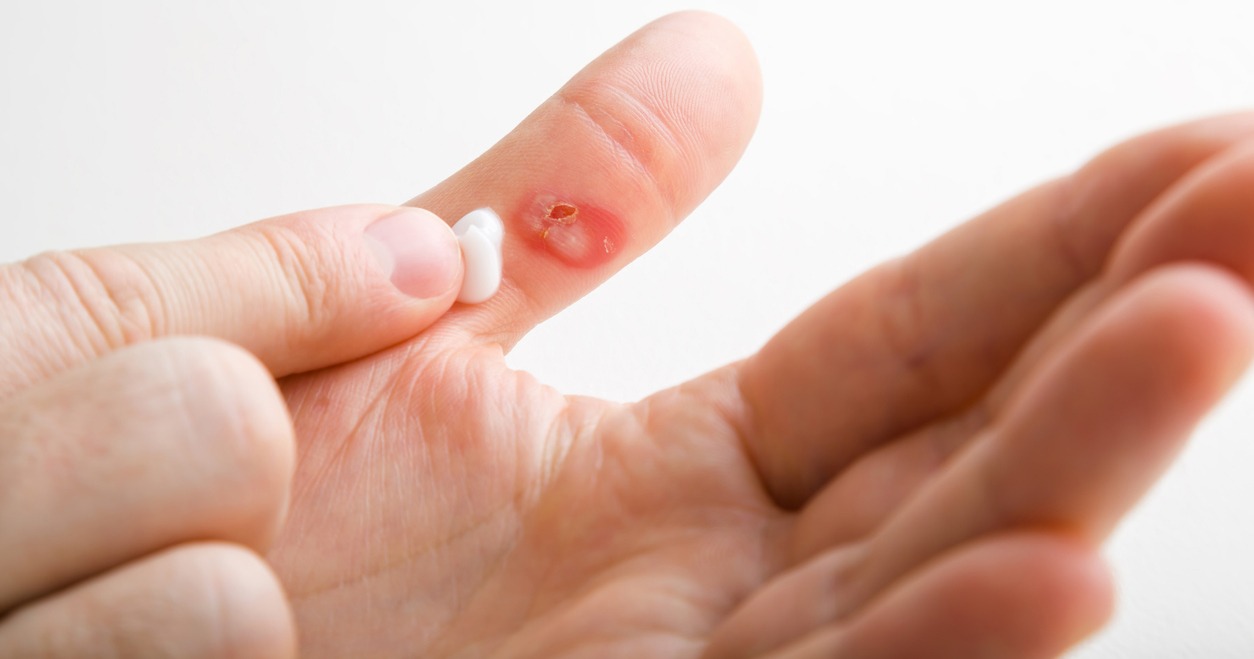Disclaimer: This article is for informational and educational purposes only and does not substitute professional medical advice. It is important to always consult a medical professional for any health issues.
Burns ranks right up there with other injuries in terms of discomfort, and if the damage is extensive, it can rank among the worst scenarios. Most injuries can be treated with first aid, but significant burns need to be treated right away by a doctor to prevent infections, which can result in serious consequences. For this reason, you should always exercise caution while handling fire or anything else that can burn your skin. [1]
A burn is defined as damage to the skin or other tissues brought on by one or more of the following: heat, cold, electrical current, chemical reaction, friction, or radiation. Most often, burns are caused by heat from liquids, solids, or fire, which is referred to as thermal burns.
With the activities we engage in on a daily basis, the majority of us frequently run the risk of suffering burns. For instance, men and women both have the potential to develop burned skin, especially when working with fire and electricity. Despite our best efforts, accidents can happen, and sometimes we still end up getting hurt. Due to this, it’s critical to understand burns and to always be ready.
Treating minor burns or caring for burns can be challenging. There are also a lot of products out there that you can use, such as ointments and creams. However, it is also difficult to know which of them are safe and effective to use on burns. If you are looking for reliable creams and ointments for burns, we are here to help you. In this post, we are giving you more information about the best ointments and creams for burns.
Different Types of Burns
Before we provide you information about the best ointments and creams for burns, let us first learn about the different types of burns. There are varying shapes and sizes of burns, and they are also due to various causes. Below are the different types of burns:
Thermal Burn
A thermal burn occurs when the skin has direct contact with a heat source. These may include an open flame from a fireplace or a candle, scalding from hot liquids like coffee spills, and touching a hot object such as a pan fresh from the stove. This is probably the most common type of burn that most people experience. In fact, thermal burn makes up almost 86% of burn patients who require burn center admission in the United States. [1]
Friction Burn
A friction burn is a combination of abrasion and heat burns. It occurs when a hard object scrapes the skin harshly or when a surface rubs on the skin repeatedly. Some of the usual cases of friction burns include carpet or rub burns. In addition to that, motorcycle and bicycle accidents may also cause friction burns when the rider scrapes their skin onto the rough road surface. This type of burn is also quite common. However, most patients do not need to seek medical attention as friction burns are usually minor. [1]
Cold Burn
Heat is not the only thing that may cause burns. It’s because even low temperatures can burn the skin. The freezing of the skin, which damages skin tissue, results in cold burns or frostbite. This happens when the skin gets exposed to arctic temperatures. A person may also get cold burns when they stay at places that have freezing temperatures. In addition, touching a cold object for a long time, such as ice cubes, may also result in a cold burn. [1]
Radiation Burn
Around two-thirds of cancer patients in the United States resort to radiation therapy for cancer treatment. Among those patients, around 85% of them experience skin irritations as a side effect. This type of burn is also sometimes called X-ray dermatitis. It is due to concentrated and high-energy X-ray beams for radiation therapy. They are used to shrink down malignant tumors and destroy cancer cells.
Aside from that, recurrent sun exposure may also result in radiation burns. Undergoing radiation therapy often may not allow the skin to regenerate. With this, the condition may lead to more severe skin irritations, such as ulcers or sores. To reduce the risk of radiation burns, using sunscreen may help. [1]
Electrical Burn
An electrical burn occurs when electricity passes through the body. This type of burn is different from other burns as it cause subcutaneous damage. This is when tissues beneath the skin also get burned. Therefore, it is difficult to diagnose and notice electrical burns. That’s why afflicted patients tend to dismiss the severity of the burn. [1]
Chemical Burn
Chemical burns are also referred to as caustic burns. They occur when a harsh irritant, such as acid or base, comes in contact with the skin. Chemical burns may occur anywhere, whether at home, at work, or anywhere else, such as when chemicals in labs or battery acids, chlorine, and bleach are mishandled. [1]
Degrees of Burns
All of the types of burns are grouped depending on the severity of the damage inflicted on the skin. These are the different categories in which the burns are classified:
First Degree Burn
First-degree burns are also called superficial burns. They are mild compared to other degrees of burn. However, they still cause pain and reddening of the epidermis or outer layer of the skin. [2] These burns only last for a few days. While most of them are manageable, medical attention is needed if the burn affects a wide surface area of the skin. [1]
Second Degree Burn
Second-degree burns are also called partial-thickness burns. This level affects the epidermis and the dermis. They may cause pain, swelling, redness, and blistering. [2] It usually takes several weeks for second-degree burns to heal. Patients also experience intense pain or skin sensitivity. Those who come down with a fever after a burn may indicate an infection in the wound. [1]
Third Degree Burn
Third-degree burns are also referred to as full-thickness burns. They go through the dermis and affect deeper tissues. This type of burn results in white or blackened, charred skin that may be numb. [2] This means that patients who experience third-degree burns often do not feel pain as the nerve endings have been damaged as well.
It is important to bring this type of burn to the emergency room immediately, as it can be life-threatening. There are also burn medical centers that specialize in severe burn injuries, offering a more professional medical treatment. [1]
Fourth Degree Burn
Compared to third-degree burns, fourth-degree burns go even deeper and can affect the bones and muscles. The nerve endings are also damaged or destroyed, and there is no feeling in the burned area. [2]
First Aid Treatment for Burns
Burns can be treated in order to help in the process of healing, as well as to alleviate the pain. Below are some of the different treatment methods that can be followed to address the damaging effects of burns: [1]
Clean the wound using lukewarm water: Doing this promotes faster healing and lessens the risk of infections. Aside from that, cooling the burn using water may also help ease the pain.
Remove accessories that may cut into the burned skin: Accessories may only scrape or rub the affected skin, damaging it further and worsening the wound. Aside from that, uncleaned accessories may also cause infection in the affected area.
Apply topical antibiotic ointment: The application of medicated ointments may help prevent and treat skin infections by mitigating bacterial growth. In addition, antibiotic ointments also help the wound heal faster.
Take pain relievers: Patients who have burned skin may experience moderate to extreme pain, depending on the severity of the burn. When the pain is unbearable, taking pain relievers may help alleviate the swelling.
Bandage the burned area: Using a sterile gauze bandage to wrap around the burned area may help keep air off the burn, reduce pain, and protect the blistered skin. Ensure that you wrap it loosely to prevent putting pressure on the burned skin.
Apply moisturizer or aloe vera: When the skin is kept moisturized, it minimizes inflammation while the burn heals. Aloe vera is an example of an anti-inflammatory ingredient that inhibits bacterial growth in the wound.
Keep the burned area protected from the sun: When the burn heals, you need to avoid sun exposure by seeking shade or applying sunscreen. The harmful UV ray of the sun usually contributes to scarring. The redness of a burn may last for weeks, particularly for those who have lighter skin tones.
Seek professional medical help: While home burn remedies may alleviate first-degree burns, second and third-degree burns, on the other hand, needs immediate medical attention as they are more severe. Therefore, do not hesitate to seek professional medical help for these conditions.
Advantages of Medicated Ointments and Creams for Burns
Over-the-counter burn care treatments, such as ointments and creams, are never a bad idea when it comes to treating minor burns at home. When caring for minor burns, there are a few side effects that you may encounter, such as dry and peeling skin, itchiness, pain, and the possibility of infection. Using OTC burn cream or ointment may help during the healing process to provide relief and peace of mind. [3]
A lot of ointments or creams come with skin-protecting or moisturizing ingredients. These aid in rejuvenating the affected area by laying the groundwork for new skin growth or rehydrating damaged skin. Most medicated topical treatments contain aloe, anti-itch ingredients, pain relievers, and antibiotics. All of these components are frequently combined in burn relief creams and ointments, which fosters the growth of healthy skin cells, the healing of wounds, and the development of scab-forming germs and microorganisms. [3]
Different Ointments and Creams for Burns
Ointments and creams are often used interchangeably. However, an ointment implies an oil-based component, and a cream implies there is none. Also, before you start using new treatments, ointments, or creams, it is better to check with your healthcare provider first to make sure that the product you will choose is the appropriate product for your needs. Below are the different ointments and creams that can be used for burns:
Aloe Vera-Based Ointments and Creams
Ointments and creams that are aloe-based are best for soothing painful first-degree burns and moisturizing damaged skin. Most of these products are safe to use on children, adults, and older adults. Most of the time, ointment for burns includes aloe in the ingredients, and it works as a gentle skin soother. Aside from that, burn relief cream for burns usually include aloe, too, if not to soothe, then to help make the healing process faster. [3] Below are some examples of aloe-based ointments and creams for burns to help you choose:
- Globe Bacitracin Zinc Ointment + Aloe: This ointment uses specially formulated bacitracin zine 500 with healing aloe to promote fast and effective healing for minor burns. It also helps prevent infections. It is easy to use and will keep your wounds clean. Just clean the burn, then apply this ointment to the wound. It can be used up to three times a day until the wound is healed.
- Miracle Ointment Aloe Vera First Aid Ointment: This first aid ointment is used to naturally soothe minor burns. It is infused with aloe vera, which is the most potent natural healing gel. It can deliver fast, cooling, and soothing relief in seconds. It contains 70% pure aloe vera gel.
- Burn Gel with Aloe Vera: This burn gel is used for immediate relief from discomfort caused by minor burns. It is a cooling gel that is infused with aloe to relieve pain. It is easy to rinse off and also works for sunburns.
Burn Relief Ointments and Creams
Many basic first-aid kits contain a small packet of “burn relief cream.” An over-the-counter burn relief cream varies between moisturizing, anti-septic, and pain-relieving topical medication. Most of them contain lidocaine and bacitracin to prevent infection. It is important to keep burns moist and infection-free to prevent future complications. These creams and ointments are also good first-aid options when the burn does not require any medical treatments. [3] Below are some examples of burn relief creams and ointments to help you choose:
- Alocane Emergency Burn Gel: This ointment has a water-based formula that is easily absorbed by the skin. It contains 4% lidocaine, which is the maximum percentage allowed by the US FDA. It can relieve pain fast while soothing the skin. It may also help relieve the itchiness of the skin. It can be applied to minor burns up to 4 times daily.
- First Aid Only Burn Cream: This burn cream can cool and soothe minor burns. They are placed in individual packets, making them easy and convenient to use.
- Dynarex First Aid Burn Cream: This cream can help keep wounds clean. It is formulated with HCl and benzalkonium chloride, which can help ease the pain and protect minor burns from foreign particles. It is water-based and can help draw out and dissipate heat from minor burns. It is hygienic to use as it comes in single-dose foil burn cream packets for clean and quick application.
- Boiron Calendula Burn Ointment: This ointment is made from a single, plant-based active ingredient, Calendula. It does not contain parabens, dyes, or fragrances. It is a good first aid treatment for minor burns caused by cooking, grilling, automobile engines, clothing irons, hot beverage spills, and more. It is a thick ointment that can stay on the skin longer to soothe, moisturize, protect, and heal.
Anti-Itch Ointments and Creams
As the skin peels off, heals, and leave scars, first-degree to second-degree burns may also begin to itch. Many burn victims often lament that the itching stage of recovery is the hardest. But there are topical anti-itch creams that can be bought over the counter in pharmacies and supermarkets. Make sure, though, that the product you purchase is an ointment for burns that also serves as a moisturizer.
When your wound is healed or closed, you can consider using anti-itch creams that contain pramoxine or hydrocortisone. However, if the wound is not yet healed, you need to follow your doctor’s instructions. A lot of anti-itch ointments and creams also contain aloe, which can moisturize and soothe the skin. [3] Below are some examples of anti-itch ointments and creams to help you choose:
- Neosporin Itch Ointment for Wound Care: This ointment contains bacitracin zinc, neomycin sulfate, and polymyxin B sulfate to provide powerful protection against infection while relieving the itchiness of your wound. It is a scar ointment that provides a nourishing environment for the skin during healing. It may also minimize the appearance of scars for a healthier-looking skin.
- Ezri Care Hydrocortisone Cream with Aloe Vera: This cream can moisturize and hydrate the skin while relieving the itch. It is a safe and effective cream that can instantly provide itch relief.
- Amazon Basic Care Maximum Strength Hydrocortisone Anti-Itch Cream: This cream contains hydrocortisone to provide relief from itchiness. It also contains vitamins A, D, and E plus aloe to soothe and moisturize the skin while relieving itch fast.
- Aquaphor Itch Relief Ointment: This itch relief ointment soothes and relieves itch and irritation for up to 12 hours. It also helps heal the itch as it contains 1% hydrocortisone. It is hypoallergenic and can be used on sensitive skin.
Pain Relief Ointments and Creams
A lot of over-the-counter ointments include pain relievers, itch soothers, and some form of antiseptic. However, if combination ones do not work for your needs, there are also pain relief creams and ointments available in the market.
When dealing with open or severe burns, you have to avoid using lidocaine-based products as they may cause severe discomfort. Try to find ointments and creams that may relieve all-around nerve and wound pain. You should also avoid putting analgesic creams and ointments on open or healing burns unless otherwise directed by your burn care provider or doctor. [3] Below are some examples of pain relief ointments and creams for burns to help you choose:
- Mirakel Maximum Strength Pain and Itch Relief Cream: This is a topical cream that contains benzocaine and resorcinol. It is fast and effective for minor burns. It also contains aloe vera and vitamins A, D, and E for soothing, healing, and hydrating properties.
- After Burn Pain Relief Aloe Gel: This topical gel can help relieve pain from minor burns. It cools the burns fast, and contain aloe vera to moisturize the skin.
- Medcosa Burn Relief Cream: This burn relief cream has a cooling effect on itchy, hot skin. It also has a temporary numbing effect to alleviate the pain of common burns, along with itching and soreness. The cream is thick, but it is not greasy. It is also safe for all skin types.
Antibiotic Ointments and Creams
Burns may leave the body susceptible to infections. It is important for open wounds to use a disinfectant, and so as for burns. Antibiotic, anti-microbial, and anti-septic ointments and creams can prevent harmful microbes and bacteria from colonizing the wound and causing infection.
For minor burns, you can use bacitracin or neomycin-based ointments. For more severe burns, you can use silver-based anti-septic ointments. Most of the time, ointments and creams that contain antibiotics are not available over the counter. This means that if your burn is already infected, you need to visit your doctor, as they may prescribe a topical antibiotic medication to treat your burn. It is always important to check with your healthcare provider before using any products, especially on burns. [3]
Conclusion
Burns are wounds that are truly painful and tend to be itchy when they start to heal. Having them can certainly affect an individual’s daily activities. Therefore, if you happen to experience burns, immediate treatment is a must to prevent the condition from worsening. Using ointments and creams is among the best treatments that you can apply to burns, particularly minor ones. However, keep in mind that when dealing with severe burns, going to the emergency room or reaching out to your doctor is important to get immediate and proper treatment. We hope this post helped you learn more about ointments and creams for burns.
References
[1] MMC, E. (2021, April 14). A guide to burns: Types, degrees, and treatment methods. MMC. Retrieved December 22, 2022, from https://www.makatimed.net.ph/blogs/a-guide-to-burns-types-degrees-and-treatment-methods/
[2] Pathak, N. (Ed.). (2020, September 15). Treating pain caused by Burns: 1st, 2nd, and 3rd degree. WebMD. Retrieved December 22, 2022, from https://www.webmd.com/pain-management/guide/pain-caused-by-burns
[3] Lacey, E. (2022, April 8). Ointments and creams recommended for use on Burns. Burn and Reconstructive Centers of America. Retrieved December 22, 2022, from https://burncenters.com/community/ointments-and-creams-recommended-for-use-on-burns/


